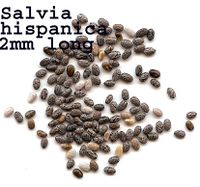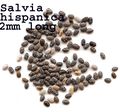Salvia hispanica
| Salvia hispanica subsp. var. | Chia, Mexican Chia | |||||||||||||||||||||||||||||||||||||||||||||||||||||||
|---|---|---|---|---|---|---|---|---|---|---|---|---|---|---|---|---|---|---|---|---|---|---|---|---|---|---|---|---|---|---|---|---|---|---|---|---|---|---|---|---|---|---|---|---|---|---|---|---|---|---|---|---|---|---|---|---|

|
|
| ||||||||||||||||||||||||||||||||||||||||||||||||||||||
| ||||||||||||||||||||||||||||||||||||||||||||||||||||||||
Salvia hispanica, commonly known as Chia, is a species of flowering plant in the mint family, Lamiaceae, that is native to central and southern Mexico and Guatemala.[1] The seeds are edible, and are also used for chia pet planters.
Chia is an annual herb growing to 1 m ft tall, with opposite leaves 4 - 8 cm long and 3 - 5 cm broad. Its flowers are purple or white and are produced in numerous clusters in a spike at the end of each stem.[2]
Cultivation
It is hardy to zone 9 and is frost tender. It is in flower from July to August. The flowers are hermaphrodite (have both male and female organs).
The plant prefers light (sandy) and medium (loamy) soils and requires well-drained soil. The plant prefers acid, neutral and basic (alkaline) soils. It cannot grow in the shade. It requires dry or moist soil.
Plants are not very frost tolerant but can be grown as summer annuals in BritainRH. This species is widely cultivated for its edible seed in Mexico. Many of the plants cultivated under this name are in fact S. lavandulifoliaRH. Members of this genus are rarely if ever troubled by browsing deer233.
Propagation
Seed - sow March/April in a greenhouse. Germination usually takes place within 2 weeks. Prick out the seedlings into individual pots when they are large enough to handle and plant out in late spring or early summer. The seed can also be sown in situ during April/May, though this sowing might not mature its seed in a cool summerRH.
Pests and diseases
Varieties
Gallery
-
photo 2
-
photo 3
References
- ↑ Cite error: Invalid
<ref>tag; no text was provided for refs namedGRIN - ↑ Anderson, A.J.O. and Dibble, C.E. "An Ethnobiography of the Nahuatl", The Florentine Codex, (translation of the work by Fr. Bernardino de Sahagún), Books 10-11, from the Period 1558-1569
- Plants for a Future is the source of some of the creative commons text in this article
External links
- w:Salvia hispanica. Some of the material on this page may be from Wikipedia, under the Creative Commons license.
- Salvia hispanica QR Code (Size 50, 100, 200, 500)

